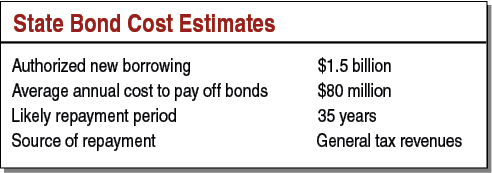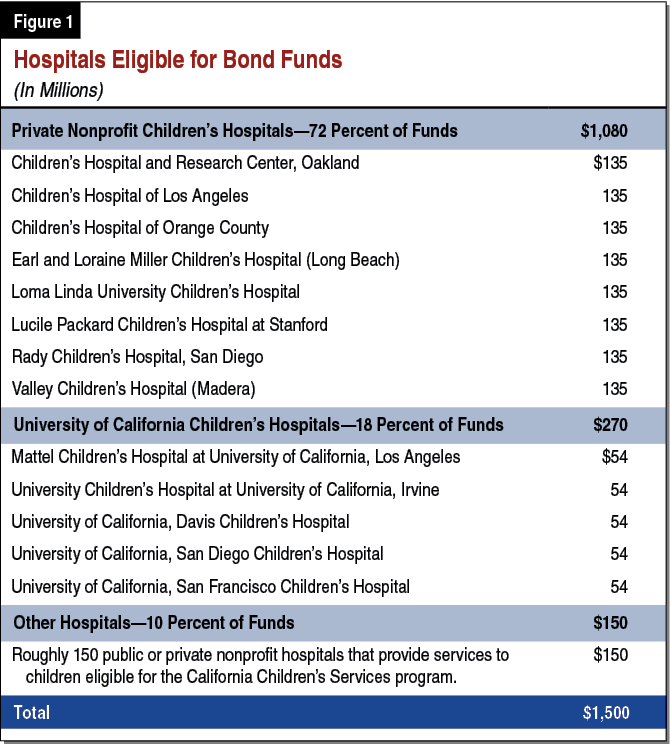Ballot Pages
Propositions on the November 6, 2018 Ballot
November 6, 2018Proposition 4
Authorizes Bonds Funding Construction at Hospitals Providing Children’s Health Care. Initiative Statute.
Yes/No Statement
A YES vote on this measure means: The state could sell $1.5 billion in general obligation bonds for the construction, expansion, renovation, and equipping of certain hospitals that treat children.
A NO vote on this measure means: The state could not sell the $1.5 billion in general obligation bonds proposed for these purposes.
Summary of Legislative Analyst’s Estimate of Net State and Local Government Fiscal Impact
-
Increased state costs to repay bonds averaging about $80 million annually over the next 35 years.

Ballot Label
Fiscal Impact: Increased state costs to repay bonds averaging about $80 million annually over the next 35 years.
Background
Children’s Hospitals. State law identifies eight private nonprofit hospitals and the children’s programs at the five University of California (UC) academic medical center campuses as “children’s hospitals.” Children’s hospitals focus on treating infants and children with severe illness or injuries, or complex chronic health conditions that require specialized care. Many children receiving services in these hospitals are from low-income families. Children’s hospitals receive funding from several sources. A majority of children’s hospitals’ funding comes from the federal-state Medicaid program (known as Medi-Cal in California), which provides health care coverage to low-income children in the state. Children’s hospitals also receive funding from commercial health insurance coverage, other government health care coverage programs, and private donations.
California Children’s Services (CCS) Program. The CCS program is a state-local health care coverage program that pays for specialized treatment and other services for children with complex chronic health conditions, including many children treated at children's hospitals. (Most children in the CCS program are also enrolled in Medi-Cal.) The state approves hospitals and other medical providers to receive payment for treating children in the CCS program.
Other Hospitals Also Treat Children. Other hospitals in California that are not specifically identified as children’s hospitals in state law also focus to varying degrees on children’s health care. For example, some hospitals have wings or centers that specialize in treating children. These hospitals are often approved to treat children in the CCS program.
General Obligation Bonds. The state borrows money to pay for long-term capital projects by issuing general obligation bonds. The repayment of these bonds is guaranteed by the state’s general taxing power. The state repays general obligation bonds from the General Fund, the state’s main operating account. (For more information on the state’s use of bonds, see “An Overview of State Bond Debt” later in this guide.)
Previous Children’s Hospital Bond Measures. Voters have previously approved two statewide measures that authorized the state to issue general obligation bonds to pay for capital projects at children’s hospitals. These bonds have been used for a variety of projects including the construction of new buildings and the renovation of existing buildings. In 2004, Proposition 61 provided $750 million in bond funding. In 2008, Proposition 3 provided $980 million in bond funding. Only the 13 hospitals specifically identified as children’s hospitals in state law are eligible to receive funds under these previous measures. As of May 2018, most of the funding from the previous two measures had been committed to projects, with the remaining funds expected to be fully committed by the end of summer 2018.
Proposal
Authorizes Additional Bonds for Children’s Hospitals. This measure authorizes the state to sell an additional $1.5 billion in general obligation bonds for capital improvement projects at (1) the 13 children’s hospitals and (2) other public or private nonprofit hospitals that treat children eligible for the CCS program. As shown in Figure 1, the measure provides 72 percent of the bond funds—roughly $1.1 billion—to the eight private nonprofit children’s hospitals. Each of these eight hospitals may apply for an equal share of this funding. The measure provides 18 percent of the bond funds—$270 million—to the five UC children’s hospitals. Each UC children’s hospital may apply for an equal share of this funding. The measure makes available the remaining 10 percent of bond funds—$150 million—to roughly 150 other public or private nonprofit hospitals that provide services to children who are eligible for the CCS program. The measure does not set aside specific shares of this portion of bond funds for individual hospitals.

Use of Funds. The measure allows for the money raised from bond sales to be used for various purposes, including “construction, expansion, remodeling, renovation, furnishing, equipping, financing, or refinancing of eligible hospitals in the state.” The measure requires that the funds provided not exceed the total cost of a project and funded projects be completed within a “reasonable period of time.”
Application Process. Children’s hospitals eligible to receive bond funds under this measure would apply for funds to the California Health Facilities Financing Authority (CHFFA), an existing state agency. CHFFA would decide whether to award a grant based on several factors. Some of these factors include whether:
-
The grant would contribute toward the expansion or improvement of health care access for children who are eligible for governmental health insurance programs or who are low-income, underserved, or uninsured.
-
The grant would contribute to the improvement of child health care or pediatric patient outcomes.
-
The applicant hospital would promote pediatric teaching or research programs.
Fiscal Effects
State Bond Repayment Costs. This measure would allow the state to borrow $1.5 billion by selling additional general obligation bonds to investors, who would be repaid, with interest, using the state’s general tax revenues. The cost of these bonds would depend on various factors—such as the interest rates in effect at the time they are sold, the timing of bond sales, and the time period over which they are repaid. We estimate that the cost to taxpayers to repay the bonds would total $2.9 billion to pay off both the principal ($1.5 billion) and interest ($1.4 billion). This would result in average repayment costs of about $80 million annually over the next 35 years. This amount is less than one-tenth of 1 percent of the state’s current General Fund budget. Administrative costs, paid from the bond funds, would be limited to CHFFA’s actual costs or 1 percent of the bond funds, whichever is less.